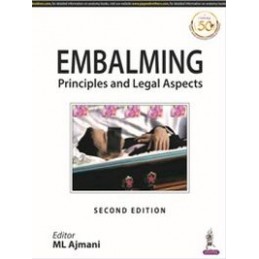- Reduced price

Order to parcel locker

easy pay


 Delivery policy
Delivery policy
Choose Paczkomat Inpost, Orlen Paczka, DHL, DPD or Poczta Polska. Click for more details
 Security policy
Security policy
Pay with a quick bank transfer, payment card or cash on delivery. Click for more details
 Return policy
Return policy
If you are a consumer, you can return the goods within 14 days. Click for more details
1. The Origin and History of Embalming
2. Environment and Personal Health Considerations
3. Death and Postmortem Changes
4. Mummification
5. Anatomical Considerations
6. Surface Anatomy and Exposure of Blood Vessels
7. Embalming Chemicals and Fluids
8. Embalming Fluids and the Safe Levels of Formaldehyde
9. Practical Embalming
10. Injection Technique
11. Cavity Embalming
12. Embalming the Unautopsied Adult Bodies
13. Preparation of Autopsied Bodies
14. Embalming the Infant
15. Delayed Embalming
16. Selected Conditions
17. Effect of Drugs on the Embalming Process
18. Guidelines for Embalming an Acquired Immunodeficiency Syndrome Body
19. Cosmetics and Presentation
20. Embalmers Legal Responsibility
21. Soft Embalming
22. The Law and the Dead
23. Establishment of the Embalming Facilities
24. Formaldehyde and Paraformaldehyde Study in Funeral Homes
25. Formaldehyde Vapor Emission Study in Embalming Rooms
26. Formaldehyde Study in Preparation Rooms
27. Reported Studies on Effects of Formaldehyde Exposure
28. Recommendations for Prevention of HIV Transmission in Healthcare Settings
29. Mobile Embalming Unit for the Preparation of Specimens for Anatomical Studies
30. Exposure to Formaldehyde in Anatomy:: An Occupational Health Hazard
31. Phenoxyethanol as a Nontoxic Substitute for Formaldehyde in Long-term Preservation of Human Anatomical Specimens for Dissection and Demonstration Purposes
32. Formaldehyde in Pathology Departments
33. Danger of Infection
Index
Data sheet
